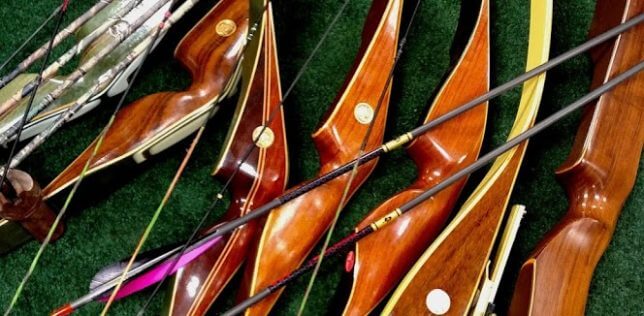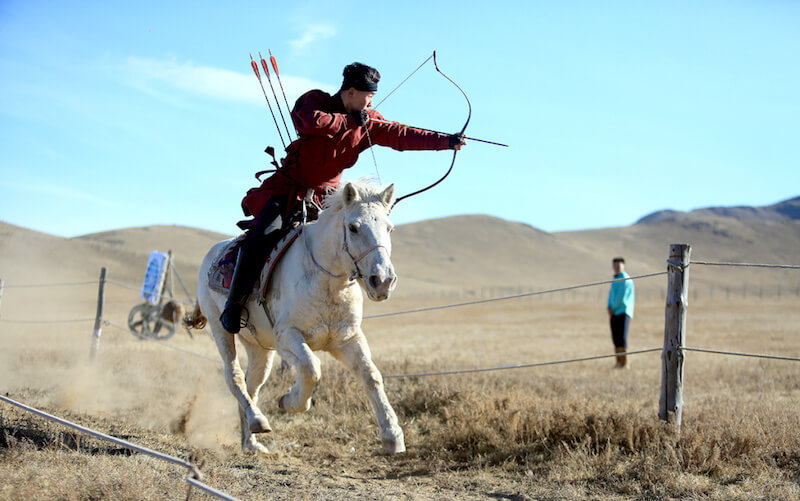Have you ever been rooting around in your attic or basement and stumbled across a recurve bow that you haven’t seen for years? It’s just been sitting gathering dust and cobwebs for the last decade. You might even be tempted to take it for a spin down at the range to see if it still performs the way it used to. But before you do that, you need to ask the question, are old recurve bows safe to shoot?
In general, old recurve bows are safe to shoot, but there are still a couple of things to consider before firing off some test arrows. Check every aspect of the bow, including the limbs, limb tips, and bowstring. Make sure there are no cracks, splinters or signs of delamination that could potentially result in the bow’s failure.
Revisiting an old recurve bow can be fun, but it’s worth noting that you still need to make sure that old recurve bows are safe to shoot.
In this article, we’ll look at whether or not the ancient really old recurve bows are still safe to shoot, and also their more modern counterparts that have been left standing for a few years.
Are Old Recurve Bows Still Safe To Shoot?
Safety should always be a top priority when shooting any bow, including old recurve bows.
Thankfully, several factors contribute to the safety of these traditional weapons.
Contributing Safety Factors
First and foremost is the quality of materials used in constructing the bow. Old recurve bows were traditionally crafted from natural materials like wood, horn, and sinew.
These materials possess inherent strength and flexibility when properly seasoned and treated.
However, it’s important to inspect older bows for signs of degradation or damage that may compromise their structural integrity.
Furthermore, the general condition of the bow is paramount for safety. Regular inspections should be conducted for cracks, splinters, or loose parts that could cause catastrophic failures during shooting.

It’s also important to check the strength and condition of the string and limb tips. If the string is showing any signs of fraying or breaking, then it’s probably best to replace it before you shoot.
If there are any signs of splintering around the limb tips or in the string grooves, these issues will also need to be addressed.
This helps prevent accidents when drawing or shooting arrows.
By knowing these safety factors, archers can shoot old recurve bows confidently. They can ensure their own safety and protect these amazing historical items.
Evaluating Safety Factors in Old Recurve Bows
Bow material and construction techniques used in older models
Old recurve bows were crafted using a variety of materials, each with its own safety considerations.
Traditional bows often featured limbs made from wood, such as yew or bamboo, which provided strength and flexibility.
Horn and sinew were also commonly used for reinforcement. These organic materials may have certain limitations due to their natural properties, but they can still be safe to shoot if properly maintained and inspected.
Modern materials used in later models
As time progressed, modern advancements led to the introduction of new materials like fibreglass in recurve bow construction.
Fibreglass limbs enhanced durability and performance while reducing the risk of breakage compared to traditional materials.
Pay close attention to the limb tips as they are particularly prone to stress fractures.
Consider the safety of old recurve bows versus modern ones. Check how well modern components have endured over time.
Look for delamination or cracks on fibreglass limbs. Ensure no loose parts or damages that could affect safety.
Stringing and unstringing techniques to prevent accidents
Proper stringing and unstringing techniques are vital to maintaining the safety of an old recurve bow.
When stringing the bow, follow the recommended methods to avoid limb twists or damage. This may involve using a stringer tool or applying even pressure on both limbs simultaneously.
Unstringing should also be done with caution, as a sudden release of tension can cause serious accidents.
Always make sure to observe unstringing precautions by gradually releasing the tension while keeping fingers and body parts clear of the string’s path.
A Brief History of Recurve Bows
To truly appreciate the allure of old recurve bows, we must embark on a journey through time. The roots of recurve bows can be traced back to early civilizations such as the Mongols, Persians, and Egyptians.
These masterful archers were known for their ability to strike targets accurately over long distances with remarkable force.
The genius behind recurve bows lies in their distinctive shape – the elegant curvature at both ends that enhances their performance.
This design innovation allowed archers to achieve greater power and accuracy compared to traditional straight-limbed bows.
With origins deeply rooted in hunting and warfare, recurve bows became an emblem of strength and dominance on battlegrounds throughout history.
Shooting Old(er) Recurve Bows with Caution
Shooting old recurve bows can bring a sense of nostalgia for past times or create a feeling of adventure. But it’s vital to make safety your top priority.
These ancient weapons may captivate our imaginations. However, ignoring safety rules could result in accidents or injuries.
We have to handle old recurve bows carefully. They’re not just old artefacts. They’re complex pieces with unique features shaped by various times and cultures.
Factors such as materials used, craftsmanship techniques employed during construction, maintenance history, and condition contribute to their safety quotient.
By acknowledging these aspects, we can ensure a secure and enjoyable archery experience while preserving the legacy of these remarkable bows.
Understanding Old Recurve Bows
Definition and Characteristics of Old Recurve Bows
When we talk about old recurve bows, we’re not just referring to the old bows you have gathering dust in your garage, but also those beautiful weapons from a bygone era.
These bows are typically crafted with traditional materials, such as wood, horn, and sinew.
Unlike modern compound bows that use mechanical pulleys and cables, old recurve bows only use the natural bend of the limbs to shoot arrows.
These bows have a unique shape. The tips of the limbs bend away from the archer when it’s not strung.
This design allows for greater power and efficiency in shooting. The craftsmanship of old recurve bows is genuinely remarkable.
Artisans meticulously carved these works of art, often incorporating intricate engravings or embellishments that showcase their skill and creativity.
Many archers today appreciate the historical value and nostalgia associated with these bows, as they harken back to a time when archery was not just a sport but also an essential tool for hunting or warfare.
Different Types of Old Recurve Bows
Within the realm of old recurve bows, there are various types that enthusiasts can explore depending on their personal preferences or historical interests.
Horsebows are another fascinating category. Originating from Central Asia, horse bows were designed specifically for mounted archery during nomadic times.

These short yet powerful bows possess incredibly compact frames which allow riders to manoeuvre swiftly while maintaining lethal accuracy.
Each type holds unique appeal, and archers often find themselves drawn to a particular style based on their shooting preferences or historical fascination.
Maintenance and Restoration
Regular maintenance is essential to ensure an old recurve bow’s ongoing safety. Wooden components require cleaning and oiling to prevent moisture damage or warping.
Clean the bow’s surface with mild soap and water. Use suitable oil or wax for wooden bows to protect and nourish them. Replace strings regularly to maintain strength and integrity.
Bringing An Old Recurve Bow Back To Life
For more extensive restoration needs, seeking expert advice from professionals who specialize in traditional archery equipment can be invaluable.
They possess in-depth knowledge about restoring older bows and can provide guidance on specific issues that might compromise safety such as limb cracks or damaged tips.
By addressing these concerns promptly through professional services, you can help ensure that your old recurve bow remains safe for shooting.
Shooting Safely with Old Recurve Bows
When shooting with an old recurve bow (or any other type), proper shooting form and technique are paramount for personal safety as well as optimal performance.
Learning correct posture, grip, draw technique, and release will significantly reduce the risk of accidents or injuries.
It is advisable to seek guidance from experienced archers or even consider taking lessons to develop and refine these fundamental skills.
FAQs
How long can a recurve bow be left strung?
Recurve bows should not be left strung for extended periods, ideally unstring them after each use to prevent damage.
Do recurve bows go bad?
Recurve bows can deteriorate over time, especially if mistreated or exposed to extreme conditions, but with proper care, they can last for many years.
How long is a recurve bow string good for?
The lifespan of a recurve bow string varies based on usage, quality, and maintenance. Generally, a well-maintained string can last from several months to a couple of years.
What to look for when buying a used recurve bow?
When buying a used recurve bow, inspect it for signs of damage or excessive wear, check the limbs for cracks or twists, ensure the string is in good condition, and verify that the bow’s draw weight and length suit your needs.
Conclusion
Shooting old recurve bows can be a safe and enjoyable experience if certain precautions are followed.
By evaluating safety factors such as the bow’s construction, inspecting its physical condition, and employing proper stringing techniques, you can minimize potential risks.
Regular maintenance practices and seeking professional expertise for restoration needs further contribute to maintaining safety standards.
Remember that shooting safely also relies on your shooting form and technique. So, embrace the elegance of an old recurve bow while ensuring your own safety through knowledge, care, and practice.

0 Comments